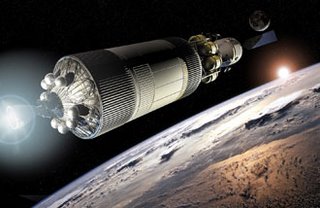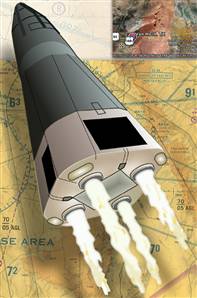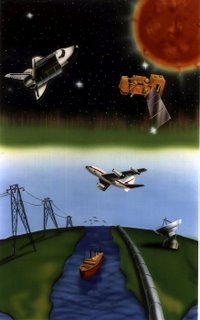7.31.2006
Euro Radio Spectrum Fight
 Something's got the European satellite industry "up in arms."
Something's got the European satellite industry "up in arms." Gerry Oberst of Hogan & Hartson's Brussel's office tunes in to the regulatory and legal implications of a United Kingdom plan to take spectrum away from satellite radio in Europe. (Via Satellite, July 2006)
Gerry explains, the UK proposes "to auction spectrum in the 1452 to 1492 MHz band, the upper part of of which "has long been designated in Europe" for satellite radio service, satellite digital audio radio (S-DAB).
Gerry expects challenges to this under English law (the UK is bound by European Union's framework for electronic communications) as well as "recent European policy initiatives on spectrum auctions, trading and service neutrality...""The band in question is one of the last available for providing European-wide services and is the result of a long, hard fight in Europe between terrestrial radio services and S-DAB - a fight the satellite sector largely lost. Now, if the United Kingdom carves out that last remaining frequency range, the prospects of providing satellite radio into the country, and the economics of providing it across Europe, will be seriously damaged."
"It has been generally recognized that the international nature of satellite footprint and spectrum use limits the ability of satellite companies to participate in national auctions. Satellite operators have to bid in virtually all countries within their service area, while terrestrial operators can cherry pick in a limited area but still block satellite development over an entire continent. This is, in effect, what would happen with the Ofcom plan."As Gerry notes, the "United Kingdom has traditionally been good to satellite interests." He warns that, "[t]aking spectrum away from satellite radio means this sector will have no future of contributing to the U.K. economy in the same way the industry has developed in the United States." Stay tuned.
7.28.2006
The NASA Whisperers
 Along with those celebrating Evoloterra, another successful shuttle mission and a staff of hurricane heroes (thanks, Michoud), folks in government and the private space sector have been clearly and none too quietly communicating doubt and disagreement with regard to NASA's planning and accounting.
Along with those celebrating Evoloterra, another successful shuttle mission and a staff of hurricane heroes (thanks, Michoud), folks in government and the private space sector have been clearly and none too quietly communicating doubt and disagreement with regard to NASA's planning and accounting.But how well will the galaxy's leading space agency hear the recent rounds of criticism? For now, NASA will make a point of "nonconcurring."
For the SLP record . . .
- Government Accountability Office's (GAO) reports unfavorably, to say the least, on the CEV program - NASA: Long-Term Commitment to and Investment in Space Exploration Program Requires More Knowledge (GAO-06-817R, July 17, 2006) This document includes, as enclosure I, NASA deputy administrator Shana Dale's response, dated July 6, 2006)
- Congresspeople pile on.
- Space Frontier Foundation slams NASA with an 18-page white paper, Unaffordable and Unsustainable? Signs of Failure in NASA's Earth-to-orbit Transportation Strategy (July 25, 2006)
- Much blogspace commentary on all this (which I won't individually link here, except to note that Keith Cowing calls the negative reports a wakeup call).
Oh boy.
So what's next? Well, Congressional hearings, of course.
7.27.2006
Gravity & ITAR
 Leonard David reports on reaching escape velocity from the red tape of US export controls. (Space.com)
Leonard David reports on reaching escape velocity from the red tape of US export controls. (Space.com)As Mike Gold, corporate counsel of Bigelow puts it, "Second only to gravity, the force that had the greatest potential to keep Genesis-1 on the ground was the ITAR." Indeed.
Among other things, Mike would like to see export control returned to the Department of Commerce. He also suggests different regimes for commercially available technology vs. militarily sensitive hardware, and "more discretion built into the system."
Meanwhile, thanks to ITAR, the commercial space industry here on Earth must grappple with one force of nature too many.
(Image: JadeTower)
7.26.2006
Planet Bezos, West Texas
 Who knew West Texas ranchers would be such fans of personal spaceflight? Indeed, looks like Amazon billionaire Jeff Bezos picked a super spot for his private suborbital spaceport.
Who knew West Texas ranchers would be such fans of personal spaceflight? Indeed, looks like Amazon billionaire Jeff Bezos picked a super spot for his private suborbital spaceport.Alan Boyle showed up in Van Horn for yesterday's FAA environmental assessment hearing for Blue Origin, and reports, "nary a discouraging word was heard." Read his very interesting coverage which includes background on the venture. (MSNBC.com)
And if you haven't treated yourself to it already, here is the 229-page Draft Environmental Assessment for the Blue Origin West Texas Commercial Launch Site.
Alan has details here.
As we have learned, Blue Origin is seeking "to launch space flight participant-carrying RLVs on suborbital, ballistic trajectories to altitudes in excess of 99,060 meters (325,000 feet) above mean sea level." To do this, Blue Origin will "construct a private launch site, including a vehicle processing facility, launch complex, vehicle landing and recovery area, a space flight participant training facility, and other minor support facilities" on Bezos-owned land in Culberson County, Texas. "Operations at the launch site would include pre-flight processing, launch, flight, landing, and recovery activities." Thus, Blue Origin needs FAA experimental permits, a launch site operator license, RLV mission-specific licenses, and/or RLV operator licenses, as appropriate.
Lest we ever forget, issuing permits and licenses are federal actions and are subject to review as required by the National Environmental Policy Act (NEPA) of 1969, as amended, 42 United States Code (U.S.C.) § 4321, et. seq. Hence the EA. And I did enjoy the hefty document, not just for the description of Blue Origin's plans and its New Shepard RLV, but also the insight into southwestern Texas flora and fauna.
Really, where else will you read that, "[t]wo black-tailed prairie dog colonies occur in the vicinity of the launch site." And, a "small cave located along the eastern side of the limestone ridge in the west-central portion of the surveyed site contained a small colony of bats during the April 2005 survey." Among his new neighbors Jeff may count the common black hawk, gray hawk, Mexican spotted owl, Southwestern willow flycatcher, yellow-billed cuckoo, zone-tailed hawk, Chihuahuan mud turtle, mountain short-horned lizard, Guadalupe Mountains fescue, gypsum wild buckwheat, lots more. And no fish.
(And if the FAA ever gets tired of licensing commercial space business, it can go teach history to billionaire book peddlers. Jeff will love the agency's finding that, "The Paleo-Indian period in the [proposed spaceport] region, dating from approximately 10,000 to 6000 B.C., is characterized by small, mobile bands who subsisted on hunting large mammals such as mammoth and bison." And the "Archaic period is generally characterized by broad-spectrum hunting and gathering by small groups that traveled seasonally throughout the year within large territories." Fascinating. And apparently, surprisingly, no suborbital space ventures, until now.)
By the way, as the FAA notes in the EA, in addition to FAA licenses or permits, Blue Origin needs "a variety of Federal, state and local permits, licenses and approvals." But of course.
And if you have comments for the FAA, send them to FAA environmental specialist Doug Graham at BlueOrigin@icfi.com.
And if you find you've developed a bit of a taste for spaceport environmental assessments, (they sure can be addicting,) dig in to 279-page Final Environmental Assessment for the Oklahoma Spaceport.
So yes, go ahead, mess with space. But don't mess with Texas.
And never mess with the FAA.
7.25.2006
The Killer App


So many new books, so little vacation time.
Laura Woodmansee, author of the summer's new sizzler on Sex in Space (coming soon to Amazon), says s-e-x is "the killer app of space tourism."
I'm in no position to argue. (Come to think of it, s-e-x is, like, the killer app of just about everything, no?) Well I look forward to it -- the book, I mean -- and hope there are pictures to go along with the descriptive chapters.
Meanwhile, in other book release news, Anonymous Lawyer is now on the shelves. This is the sintilating expose on biglaw -- life at big law firms -- by blogger/lawyer Jeremy Blachman, and, as Carolyn Elefant points out, the release comes cleverly just in time for the first day of the bar exam, concurrently given in most states across the nation. No turning back now kids. (By the way, Carolyn's good review of the book is up on her blog.) And this is one publication in which I hope to find no pictures, thank you.
Well I happen to have an opening for a new hardcover to add to my beach reading list. Hmmm. Which one should I pick?
(Right-o. )
* * *
UPDATE: Speaking of s-e-x and l-a-w-y-e-r-s (ahem), this just in -- the LJOD (lawyer joke of the day). . .
Q: What do lawyers use for birth control?
A: Their personalities.
(That's right, lawyers jokes are the killer app of jokes.)
* * *
On a more serious note, SLP congratulates Laura and Jeremy on their new books, and wishes everyone good luck on the bar exam!
7.24.2006
Scenes from the Flamingo
I'll just pick out a few items to directly link:
Here are Clark's notes of the space law panel with Berin Szoka, Jim Dunstan, Rosanna Sattler; and Clark's post on the talk by FAA deputy associate administrator for commercial space transportation George Nield, which Rand also blogged here.
Rand covered Mike Beavin's discussion of the resurrection of the Department of Commerce's Office of Space Commercialization, which Clark also blogged here.
And here's Rand's report on the panel addressing spaceflight and personal risk.
By the way, Rand also thoroughly enjoy the space law panel, and this is pretty much his dispatch in its entirety: "three lawyers discussed space law." Thanks Rand! (And surprisingly, Rand did have some energy left over to cover Sunday's vigorous panel on copulation in space, about which, alas, he did not write, "three people discussed space sex" but that was the gist of it. ;-)
7.19.2006
NewSpace in Vegas
 If it's July, it's time to hit the Flamingo for some space business and all the debauchery that goes with it in Las Vegas -- this year's Space Frontier Foundation gathering, NewSpace 2006 begins Thursday and tops off Sunday with an exciting panel on space sex.
If it's July, it's time to hit the Flamingo for some space business and all the debauchery that goes with it in Las Vegas -- this year's Space Frontier Foundation gathering, NewSpace 2006 begins Thursday and tops off Sunday with an exciting panel on space sex.Don't miss the tempting Saturday panel on "Legal Issues and NewSpace," with sexy space lawyers Berin Szoka of Latham & Watkins LLP and Jim Dunstan of Garvey, Schubert & Baer. Hot.
And corporate lawyer Lowell Ness of Orrick Herrington & Sutcliff serves as one of the judges of the NewSpace 2006 Business Plan Competition. (If he picks your company you gotta hire his law firm.)
What happens in Vegas stays in space.
7.18.2006
Announcing Spaceport America
 This Sierra County cow may count herself among the few individuals who are not quite thrilled about New Mexico's grand spaceport vision. (Well, I mean she doesn't look thrilled. But then, who really knows with cows? This bovine may in fact secretly harbor her own space travel dreams....)
This Sierra County cow may count herself among the few individuals who are not quite thrilled about New Mexico's grand spaceport vision. (Well, I mean she doesn't look thrilled. But then, who really knows with cows? This bovine may in fact secretly harbor her own space travel dreams....)Never mind the space cow, New Mexico Economic Development Cabinet Secretary Rick Homans flew all the way to the Farnborough International Airshow in Farnborough, England to announce the official name of New Mexico's spaceport: Spaceport America. Indeed. And check out the hot new website. (Well? Where do you think I found the cow?) And of course, Space Law Probe already links to the Spaceport's blog, Pulsar, hosted by Tricia Ware.
The land of enchantment certainly has come a long way since Robert Goddard moved to Roswell to build rockets.
In fact, here, from Spaceport America, are "Top 10 Moments in New Mexico Space History" (which Dick Stafford also noted in a post yesterday):
10. 1929 - Ridiculed for his unconventional ideas, Robert Goddard relocates from New England to Roswell, New Mexico, to build his experimental rockets in peace. He would become known as the Father of Modern Rocketry.
9. 1946 - Wernher von Braun launches the V-2 rocket from the then-named White Sands Proving Ground, New Mexico.
8. 1961 - HAM, a chimpanzee named for Holloman Aero Medical Laboratory in Alamogordo, is the first chimp in space.
7. 1979 - White Sands Missile Range is named a landing site for NASA’s Space Shuttle. NASA missions continue through the eighties and nineties.
6. 2004 - New Mexico becomes the host for the X Prize Cup annual spaceflight exhibition.
5. September 2005 - Governor Richardson announces UP Aerospace will conduct the first launch from New Mexico’s spaceport.
4. October 2005 - New Mexico hosts the first annual X Prize Cup in Las Cruces. As many as 20,000 people attend.
3. December 2005 - Governor Richardson and Sir Richard Branson announce that Virgin Galactic will make New Mexico its world headquarters.
2. January 2006 - Governor Richardson and the New Mexico legislature enact laws providing for the world’s first purpose-built commercial spaceport.
1. July 2006 - The Spaceport America brand is unveiled at the Farnborough International Airshow.
Much more ahead. (Mooove over, Bessy.)
7.17.2006
GC's Gone Wild
 Up-and-coming space companies take note: top inhouse legal talent ain't cheap. Take a look if you dare at Corporate Counsel's 2006 compensation survey of the 100 highest paid general counsel at major corporations. (Free registration required.)
Up-and-coming space companies take note: top inhouse legal talent ain't cheap. Take a look if you dare at Corporate Counsel's 2006 compensation survey of the 100 highest paid general counsel at major corporations. (Free registration required.)This hot list features each GC's name, rank, salary, bonus and other forms of remuneration for fiscal year 2005.
Big-time bonuses are key to any compensation package of course. And the latest trend: "a surge in restricted stock grants." According to Corporate Counsel, the "average award to GC's of restricted stock rose by 35 percent, reaching almost $1 million." Not too shabby.
So how about the top law dogs at big aerospace companies who made the top 100? Let's see... ranked according to cash compensation, we have Frank Menaker of Lockheed Martin weighing in at #22. (Actually, Frank retired from Lockheed in January and became a partner at DLA Piper. Replacing Frank is James B. Comey who moved over from the DOJ. And you can just imagine the likes of that salary increase. We'll look for James in next year's survey.)
W. Burks Terry of Northrop Grumman comes in at #41 of the top 100.
I'm not sure why former Boeing chief counsel Douglas Bain, who retired in 2006, is not listed. (Best memory of Doug: in January he famously gave a speech to top company brass in which he recited the prison ID numbers of convicted former Boeing executives, saying, "These are not ZIP codes.") The new GC at Boeing, Mike Luttig, who made a big splash when he left the 4th Circuit for new frontiers, should pop up in next year's line-up. (Either that or I'd say a raise is in order.)
7.13.2006
Bigelow Inflates Space
 (Why didn't NASA think of this technology? Oh -- it did.)
(Why didn't NASA think of this technology? Oh -- it did.)Congratulations to hotel magnate Robert Bigelow and his new space company on this week's launch and successful inflation of Genesis-I, the first test in the "great adventure" of creating expandable commercial space habitats.
To commemorate, I thought this would be a good day to replay Sam Dinkin's interview of Bigelow Aerospace general counsel, Mike Gold. (The Space Review, Dec. 20, 2004.) And here on SLP we know more than a few space business lawyers who would line up to work with Mike ;)
For more background on Bigelow Aerospace and the great orbital resort adventure, check in at The Five-Billion-Star Hotel (Michael Belfiore for PopSci). (Quite the obvious evolution of Budget Suites of America, isn't it?)
* * *
(Image: artist's rendering of Genesis I, via Bigelow)
7.12.2006
Space Lawyers in St. Louis
 Last year they invaded Canada.
Last year they invaded Canada.This year, they're back in the states, as the ABA Forum on Air and Space Law's 2006 Annual Meeting brings a bunch of high-flying lawyers to the bright blue skies of St. Louis, Missouri, July 27 and 28.
I'm not sure I can find Missouri on a map, but the aviation lawyers certainly can. (Of course, Charles Lindbergh's Ryan NYP "Spirit of St. Louis," which he flew 5,810 kilometers between Roosevelt Field on Long Island, New York -- a short drive from my beach house where I happen to be blogging at the moment -- to Paris, thereby winning the $25,000 Orteig prize, was named in honor of folks in St. Louis, Missouri, who paid for Charles' plane. And I'm sure the air lawyers know all about the spacecraft that won the X Prize. But never mind that.)
The theme for the Forum's 2006 gathering: "Changing Business Models in a Shrinking World."
And alas, as always, the Forum's emphasis is on air, not space. Cherchez la air lawyers. I counted 8 panels (not to mention both keynotes) focusing exclusively on aviation law and business.
And one panel, yes one, devoted to space law: Space-based, Earth-based Profits: Changes and Challenges.
According to the brochure, this panel will address:
- consolidation of satellite manufacturing and services at the national level;
- alliances at the international level;
- NASA and the private sector;
- commercial satellite imagery and geospatial data: the challenges in developing a successful business model.
Its moderator, Prof. Joanne Irene Gabrynowicz of the National Remote Sensing and Space Law Center, University of Mississippi School of Law, hosts a hot panel: Pamela Meredith of Zukert, Scoutt & Rasenberger, LLP; Kevin D. Pomfret of McGuire Woods LLP; and Michael C. Wholley who is, of course, NASA general counsel.
A good offering; we'll take it. (Joanne, Pamela and Michael also carried the space law ball at the forum's annual meeting last year.)
But really, air law is sooo 20th century. Mark my words. This millennium, the space lawyers will blow the wings off the ABA's so-called Forum on Air & Space Law, and take over.
7.11.2006
Space Tourism is Nonsense
 One of the best things about summer is you can catch up with stuff.
One of the best things about summer is you can catch up with stuff.For example, I finally had a chance to listen to the MP3 of a broadcast of The Space Show, aired on May 26th, 2006, in which our lovable host, Dr. David Livingston, interviewed renowned space lawyer Dr. George S. Robinson. Just two PhD's chatting about space law and business.
My idea of a space show.
George Robinson, who majored in biology and chemistry, holds an LL.B. from the University of Virginia School of Law, and an LL.M. and the first Doctor of Civil Laws degrees from McGill University's Institute of Air and Space Law, served as legal counsel at the Smithsonian, international relations specialist at NASA, and legal counsel at the FAA, authored more than 100 articles and books on space law, space commerce and lots of other topics, and is "currently is working on his next book addressing the establishment of a unique jurisprudence to accommodate individual personhood of transhumans functioning in space," offered some surprising and let's just say unique insights.
Among other things, he called space tourism "nonsense," and warned space businessfolks to be wary of unscrupulous government regulators. He called the Outer Space Treaty wishful thinking and said treaties, like all laws, are made to be broken.
In case you missed it, here are some highlights.
On commercial space business
To get into space business you "really have to be smart" in terms of not just traditional concerns of securing risk capital but in protecting products from private competitors and insuring that the multitude of insuring financial and investment and tech transfer regulations, for example, both domestic and international are satisfied. Many folks starting out in this business don't recognize that and the last thing many want to do is consult a lawyer. The entrepreneur has to protect from "frequently unscrupulous competition." This comes from government regulators -- domestic and foreign governments -- and "the cabals that are established between and among those regulators, the politicians and the major national and international corps."
"Legal theft is not unheard of" "and protection by and from governments is not altogether the order of the day."
Governments have vested interests in major corporations, political considerations, international diplomatic considerations and "everything is an expendable chip whether it's related to space or not."
"Frankly, I have found over the years there are folks in the federal government who work with space activities who are not above favoritism and particularly with major corporations who might find that a startup or mid-level entrepreneur's product or service is competitive with what they're doing."
"And I've found also over the years, and a lot of folks starting up don't understand this, that what major businesses will do, in space commercialization as in anything else, if they see an up-and-coming product or service that might be competitive with something they have already established and are making a lot of money from they'll simply take it themselves whether it's secured by property rights, patented or what have you, and use it themselves or take it and put it on the shelf and simply say 'we don't think your patent covers what we're doing with the same product or the same service... and if you don't like it you have your legal resources,'" -- knowing full well that most start-ups and mid-level companies "simply do not have the money to contest this type of behavior." This is not limited to the space commerce, it happens across the board with major corporations.
"Unfortunately, there are people both in and out of the government who find that most of their commercial epiphanies come from greed."
Sometimes it's too late, and a product is put out into the market unprotected. A good place to start to protect yourself and your investors is talk to legal counsel.
On non-disclosure agreements
George has drafted, formulated and used a number of NDA's over the years. The more valuable product or service appears to be, the less secure you are in your NDA provisions. In the space industry, very few people read NDA's and some of the biggest violators are members of Congress, and the federal government. A lot of folks who are not working in contracts offices don't even know what an NDA is. NDA's can be helpful. There are honest people in the business, too. But if there is a problem, legal fees and court costs, etc. raise a practical issue of whether you can enforce.
On property rights
In the treaties there is no right of any nation to assert sovereign ownership over space or its resources and that's problematic to me. There are an awful lot of resources in our solar system, galaxy, universe. To say you can't own property is very misleading. It's going to happen anyhow and it does happen in terms of some of our exploitation. So much of this is open, if you want to do it and you have the capacity, just do it because I don't know any body who is going to be sending tanks up there to stop you.
"I never believed that the OST of 1967 was a self-executing treaty. It's a statement of wishes from good intent negotiated principally by the former Soviet Union and the US, neither of which knew what the other's capacities were in space." There is a lot of flexibility there.
"I think it's amorphous enough that whoever does it first is going to have a lot of say on what constitutes private ownership of property and what's acceptable."
On the Moon Treaty
"I have never been a strong proponent of the moon treaty. I think it was negotiated by ideological amateurs."
I think in the long run most people have seen that [the Moon Treaty] was really a problem thatdisenfranchisedd the world of economic capital from investing risk capital of a large nature for obtaining space resources and using them.
I don't think the common heritage provisions in the Moon Treaty and OST are self-executing, they require each nation that signs to implement those provisions. Implementing has been attempted in this country but "seems to always come to a screeching halt... because of military obstacles." The whole concept of property and space resources needs to be settled in court. In a case involving a UScorporationn, it may go before a commission or the World Court; it might end up in the Supreme Court.
At a minimum you have to assert control. Drilling a hole doesn't constitute assertion of ownership.
On the legal system
The outfit with the most money can win.
On who owns the Moon
No one owns the moon at this time.
On VSE and the US establishing habitats on the Moon and Mars
There are different treaty provisions and authoritative interpretations that apply. Even though you can't own the land on the Moon or Mars you can control certain use of it that might be reasonable but you also have to make it available by reasonable visitation other space-faring nations. That's not going to cut it if it's a military station not just a benign colony. Other provisions are in the Rescue and Return Treaty; Liability Treaty.
On withdrawing from or renegotiating OST
"Why withdraw from something that you are not required by law to do or not do?" These provisions are wishful thinking. You need very specific implementing positive law for, by and large, each of these provisions. Under rebus sic stantibus, if the circumstances have changed the law is no longer applicable. The facts have changed.
"It may take a lot longer to amend the OST than makes it worthwhile, I'd rather negotiate a whole new treaty at the appropriate time that covers a lot of things. Treaties are made to be broken like any other laws; it's a question of to what extent you want to enforce them."
On whether George's view is unique
It's not unique, it's very practical; based on a lot of experience.
On the future of humans in space
The only future of humans is off this planet. Earth is temporary. I don't think Stephen Hawking needs to tell me it's only temporary. It is absolutely critical that our species and its descendants get off this planet, this is an integral part of biological evolution or biotechnical evolution; this species is not going to last on the planet. "This is the ninth month. We're being born. Now." In terms of getting that done, we have some very far-thinking and good people. And then we have some people who are ripping the whole effort off for personal gain.
On space tourism
I am not a proponent of space tourism. I think it's nonsense. The human body at this point is infinitely too fragile for long duration and permanent habitation in space. We don't have the ability, significantly unenhanced, to survive microgravity, radiation; it just isn't gonna happen without substantial alteration, which we are developing the capacity for.
Transhumanism and posthumanism is a lot further along than most people realize.
The real problem is, you can't tell people here on earth they're never going to get off and the planet is doomed. Survival is the reason for environmentally stabilizing the planet -- that is so we can use our resources to get the ensuing generations, "the envoys of mankind" off the planet permanently. And I think that will be in some veryspohisicatedd human-robotic entities. Space tourism? 99.999% of the people in the world ain't ever going to get there.
On future envoys
You're not going to put everybody on earth who wants to go to space in space. You're going to have envoys. And you've got to understand what those envoys are. They are going to be sufficiently changed that their independent personhood will subject them to a totally different accountability under a totally different set of legal regimes and jurisprudence that we haven't anticipated yet.
We need to have a manned program but it cannot be for long duration and permanence habitation of space without significant alteration. We are capable of this and have a done a lot on that respect. (Recording cuts off here.)
* * *
If you get a chance, listen to the whole thing. I don't quite always agree with George, but he is a seasoned, smart lawyer who never minds speaking his mind. Which is to be admired. And I am sure looking forward to George's new book. (Hopefully ready by next summer...? ;)
7.10.2006
Not Necessarily Beach Reading
 Just in time for the beach . . . or not?
Just in time for the beach . . . or not?The Space Security Index, "a research partnership between several academic, governmental, and non-governmental organizations, who together make up the consortium, Spacesecurity.org" -- and yes, partners include the Institute of Air and Space Law at McGill University, along with Project Ploughshares, the Simons Centre for Disarmament and Non-Proliferation Research at the University of British Columbia, and the Space Generation Foundation -- have released their 1.2 MB publication, Space Security 2006 (July 2006).
(Or, if you prefer, and at this time of year I typically do, the executive summary.)
For those unfamiliar with the project, here is some background:
Space Security 2006 aims to provide a comprehensive and integrated assessment of the state of space security. It is the third such annual evaluation of space security, which for these purposes is defined as the secure and sustainable access to and use of space, and freedom from spacebased threats. The report examines international developments in space security according to eight indicators, providing a comprehensive overview of the concerns of military, civilian, and commercial space stakeholders from around the world.
This project accepts the position that space is a global commons, as enshrined in the 1967 Outer Space Treaty, bordering every community on Earth. There is no doubt that national and international security dynamics on Earth and space security are interlinked: space systems can enhance national security by providing transparency and by supporting military operations and international security concerns on Earth risk spilling over into the space environment.
However, our approach posits that there are policies that can enhance the security of all actors in space. Space security need not be a zero-sum game but instead can be a path to prosperity and a path to peace.
The pursuit of space security is plagued by certain contradictions. For example, the acquisition of independent space access by more actors could aggravate environmental concerns in space. Technologies that enable more effective use of space for some often have the inherent potential to negate the secure use of space for others. Indeed, the same assets used for space surveillance and collision avoidance could provide precision targeting of space assets. These contradictions are commonly interpreted from the national security vantage points of individual space actors. However, these concerns need to be explored and collectively managed, and, by their very nature, require a common understanding of space security. We expect this report will provide food for thought in this regard. It is our hope that Space Security 2006 will improve the transparency.
And FYI, those "eight indicators" are:
A heafty undertaking. I personally know a lawyer who is at the office downloading the report at this moment. Of course for others, this sort of thing may be just too hardcore for under the sun umbrella drinking frozen Margaritas. Up to you.
Pass the chips?
7.07.2006
Fragile Space
 Hot off the American Institute of Aeronautics and Astronautics (AIAA) press, I just ordered a copy of Space: The Fragile Frontier, a new book by space technology consultant, physicist and engineer Mark Williamson.
Hot off the American Institute of Aeronautics and Astronautics (AIAA) press, I just ordered a copy of Space: The Fragile Frontier, a new book by space technology consultant, physicist and engineer Mark Williamson.According to AIAA's press release, this "is the first book to draw together the recognized issues of Earth orbital debris and planetary protection, set them in the context of space law and ethical policies, and encourages a balance between desirable expansion into space and protection of the space environment. By analogy with terrestrial environmentalism, it calls for a sustainable approach to space exploration and development."
Sounds interesting; I'm looking forward to it. And if you've read Mark's book and would like to guest review or share thoughts on it here on SLP, let me know.
7.06.2006
Canada Space Workers Strike
 This is not Space Labor Probe but I did want to note that while the Discovery docked with the space station today, Canadian space engineers continued their walkout.
This is not Space Labor Probe but I did want to note that while the Discovery docked with the space station today, Canadian space engineers continued their walkout.* * *
BRAMPTON, ONTARIO – On June 21, for the first time in its 28 year history, the SPATEA (SPAR Professional and Allied Technical Employee’s Association) has gone on strike. SPATEA is a professional association of engineers, scientists, technologists, contract administrators, and allied technical staff employed by MDA Space Missions of Brampton, Ontario. The previous collective agreement expired on December 31, 2005 and negotiations have been ongoing since January 12, 2006.
Formed in 1977, the Association membership has designed Canadian icons like the Canadarm and the Mobile Servicing System used on the International Space Station (including the Canadarm II and Dextre). In addition to its normal duties, the Canadarm is used to inspect the heatshield system of the Space Shuttle to ensure the safe return of the spacecraft and its crew of astronauts. Currently SPATEA members are involved in the design and development of robotic manipulators for nuclear facilities, neurosurgical equipment, scientific instruments for Mars missions, and 3D vision systems.
* * *
Read the full SPATEA news release, dated July 5. And yes, the strike is about salaries.
(Hat tip: Spaceref. )
7.05.2006
Space Law Conference in Bangkok
 A reminder: the International Institute of Space Law (IISL) along with the the Thailand Ministry of Information and Communication Technology will host Space Law Conference 2006: Asian Cooperation in Space Activities: A Common Approach to Legal Matters, August 1-4, 2006 at the Asia Hotel in Bangkok, Thailand.
A reminder: the International Institute of Space Law (IISL) along with the the Thailand Ministry of Information and Communication Technology will host Space Law Conference 2006: Asian Cooperation in Space Activities: A Common Approach to Legal Matters, August 1-4, 2006 at the Asia Hotel in Bangkok, Thailand.SLP sends regards to the conference including IISL president Dr. Nandasiri Jasentuliyana.
World-traveling space law expert Prof. Joanne Gabrynowicz of the University of Mississippi's National Remote Sensing and Space Law Center will appear on a panel addressing the International Charter on Space and Major Disasters. (Note: Joanne, who did wear an abaya in Saudi Arabia, is expected to sport her regular business/casual attire in Bangkok ;)








